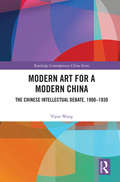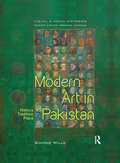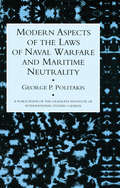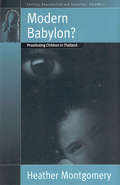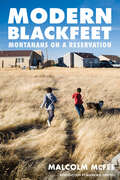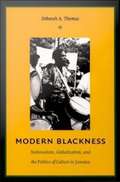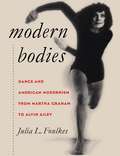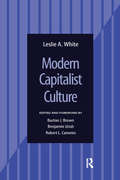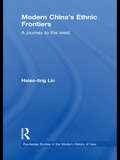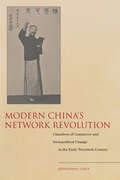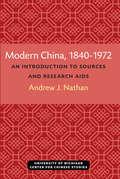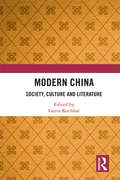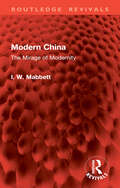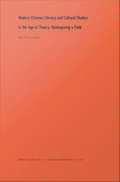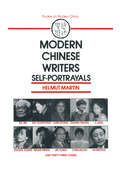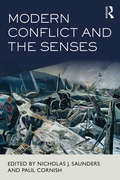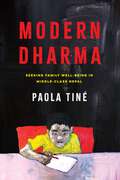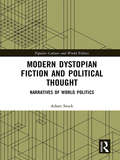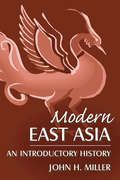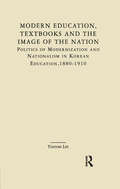- Table View
- List View
Modern Armenia: People, Nation, State
by Gerard LibaridianModern Armenia reviews Armenian politics and political thinking from the mid-nineteenth century to the present, and the evolution of Armenians from peoplehood to statehood. Written by a key governmental advisor in the early years of Armenian independence, this book analyzes the internal dynamics of the revolutionary movement, the genocide, the Armenian Diaspora, its recovered statehood and recent independence, as well as the relationship of these developments to processes in the Ottoman/Turkish, Russian, and Western states. It also explores current dilemmas and future choices independent Armenia faces today.Libaridian concludes with an overview of Armenia and Armenians during the past two decades, including the rebirth of independent Armenia, its foreign and security policy options, its position within the region, and its relations with the Diaspora. Fascinating and timely, Modern Armenia will be of interest to students and scholars of Armenian history, independence movements, the dissolution of the Soviet empire, foreign relations, and political science.
Modern Art for a Modern China: The Chinese Intellectual Debate, 1900–1930 (Routledge Contemporary China Series)
by Yiyan WangHow did art reform fit into the many initiatives for social and cultural change that contributed to the New Cultural Movement that transformed the Chinese cultural landscape during the Republican period?"Modern art for a modern China" was the rallying cry of Chinese intellectuals, many of whom were artists, critics, writers, poets and educators. Wang describes how these groups discussed and implanted changes in China’s conception and practice of art. She demonstrates how art reforms fit into the many initiatives for social and cultural change that contributed to the New Cultural Movement that transformed the Chinese cultural landscape during the Republican period. In doing so, she analyses two key areas in the intellectual history of Republican China: China’s art reform in the early decades of the twentieth century; and the connection and intersection between colonialism, nationalism and cosmopolitanism, including their direct impact on the development of art and art practice in China.Modern Art for a Modern China is an invaluable resource for scholars and students of China’s twentieth-century intellectual history and art history.
Modern Art in Pakistan: History, Tradition, Place (Visual and Media Histories)
by Simone WilleModern Art in Pakistan examines interaction of space, tradition, and history to analyse artistic production in Pakistan from the 1950s to recent times. It traces the evolution of modernism in Pakistan and frames it in a global context in the aftermath of Partition. A masterful insight into South Asian art, this book will interest researchers, scholars, and students of South Asian art and art history, and Pakistan in particular. Further, it will be useful to those engaged in the fields of Islamic studies, museum studies, and modern South Asian history.
Modern Aspects Of The Laws Of Naval Warfare And Maritime Neutrality
by George P. PolitakisFirst Published in 1991. This study covers developments up to the end of December 1996 of the legal parameters of modern naval warfare. It also discussed the role of the power of the sea modern strategy
Modern Babylon?
by Heather MontgomeryChild prostitution became one of the key concerns of the international community in the 1990s. World congresses were held, international and national laws were changed and concern over "cemmercially sexually exploited children" rose dramatically. Rarely, however, were the children who worked as prostitutes consulted of questioned in this process, and the voices of these children brought into focus. This book is the first to address the children directly, to examine their daily lives, their motivations and their perceptions of what they do. Based on 15 months of fieldwork in a Thai tourist community that survived through child prostitution, this book draws on anthropological theories on childhood and kinship to contextualize the experiences of this group of Thai child prostitutes and to contrast these with the stereotypes held of them by those outside their community.
Modern Banking in the Balkans and West-European Capital in the 19th and 20th Centuries (Routledge Revivals)
by Kostas P. KostisFirst published in 1999, Kostis in this book traces the influences Western modern banking systems in Balkan states and the economic development of these countries. The contributors of this book consider a wide arrange of approaches in relation to issues of western-European influence in Balkan countries with the aim to create a further discourse in this subject.
Modern Blackfeet: Montanans on a Reservation
by Malcolm McFeeModern Blackfeet sheds light on the politics, economics, society, and especially the acculturation of the Blackfeet Indians of Montana. The Blackfeet Reservation has an established government and an active and diverse population that has long supported itself through ranching, industry, and oil and natural gas exploration. Malcolm McFee shows why, as a result, policies and programs based on simplistic assumptions of assimilation are doomed to failure. The results of McFee&’s long-term research among the Blackfeet in the 1950s and 1960s make it clear that acculturation is not simply a linear process of assimilation or a one-way cultural adaptation to the impact of Euro-American culture. He reviews the changing policies of the U.S. government, which were directed initially at the destruction of all native customs and values, then at the promotion of Blackfeet self-government, and eventually at the threatened termination of their status. Finally and most important, McFee notes that racial identity on the reservation today is explained more by values and behavior than by biology and thus divides the community into a white-oriented majority and a smaller, Indian-oriented group dedicated to preserving the tribe&’s traditional lifeways.
Modern Blackness: Nationalism, Globalization, and the Politics of Culture in Jamaica
by Deborah A. ThomasModern Blackness is a rich ethnographic exploration of Jamaican identity in the late twentieth century and early twenty-first. Analyzing nationalism, popular culture, and political economy in relation to one another, Deborah A. Thomas illuminates an ongoing struggle in Jamaica between the values associated with the postcolonial state and those generated in and through popular culture. Following independence in 1962, cultural and political policies in Jamaica were geared toward the development of a multiracial creole nationalism reflected in the country's motto: "Out of many, one people. " As Thomas shows, by the late 1990s, creole nationalism was superseded by "modern blackness"--an urban blackness rooted in youth culture and influenced by African American popular culture. Expressions of blackness that had been marginalized in national cultural policy became paramount in contemporary understandings of what it was to be Jamaican. Thomas combines historical research with fieldwork she conducted in Jamaica between 1993 and 2003. Drawing on her research in a rural hillside community just outside Kingston, she looks at how Jamaicans interpreted and reproduced or transformed on the local level nationalist policies and popular ideologies about progress. With detailed descriptions of daily life in Jamaica set against a backdrop of postcolonial nation-building and neoliberal globalization, Modern Blackness is an important examination of the competing identities that mobilize Jamaicans locally and represent them internationally.
Modern Bodies
by Julia L. FoulkesIn 1930, dancer and choreographer Martha Graham proclaimed the arrival of "dance as an art of and from America." Dancers such as Doris Humphrey, Ted Shawn, Katherine Dunham, and Helen Tamiris joined Graham in creating a new form of dance, and, like other modernists, they experimented with and argued over their aesthetic innovations, to which they assigned great meaning.Their innovations, however, went beyond aesthetics. While modern dancers devised new ways of moving bodies in accordance with many modernist principles, their artistry was indelibly shaped by their place in society. Modern dance was distinct from other artistic genres in terms of the people it attracted: white women (many of whom were Jewish), gay men, and African American men and women. Women held leading roles in the development of modern dance on stage and off; gay men recast the effeminacy often associated with dance into a hardened, heroic, American athleticism; and African Americans contributed elements of social, African, and Caribbean dance, even as their undervalued role defined the limits of modern dancers' communal visions. Through their art, modern dancers challenged conventional roles and images of gender, sexuality, race, class, and regionalism with a view of American democracy that was confrontational and participatory, authorial and populist. Modern Bodies exposes the social dynamics that shaped American modernism and moved modern dance to the edges of society, a place both provocative and perilous.
Modern Capitalist Culture (One World Archaeology Ser.)
by Leslie A WhiteThis lost classic by famous anthropological theorist Leslie A. White, published now for the first time, represents twenty-five years of his scholarship on the anthropology of modern capitalism. Drawing out his now classic formulations of social organization, cultural evolution, and the relationship between technology, ecology, and culture, this major theoretical work traces a vast expanse of history from the earliest forms of capitalism to the detailed inner workings of contemporary democratic institutions. A substantial foreword by Burton J. Brown, Benjamin Urish, and Robert Carneiro both situates this posthumous work within the history of anthropological theory and shows its importance to contemporary debates within the discipline.
Modern Capitalist Culture, Abridged Edition (One World Archaeology Ser.)
by Leslie A WhiteThis lost classic by Leslie A. White represents twenty-five years of his scholarship on the anthropology of modern capitalism. Drawing out his now classic formulations of social organization, cultural evolution, and the relationship between technology, ecology, and culture, this major theoretical work traces a vast expanse of history from the earliest forms of capitalism to the detailed inner workings of contemporary democratic institutions. The abridged version of Modern Capitalist Culture delivers all of White’s major arguments in a clear and concise manner. A substantial foreword by Burton J. Brown, Benjamin Urish, and Robert Carneiro both situates this posthumous work within the history of anthropological theory and shows its importance to contemporary debates within the discipline.
Modern China's Ethnic Frontiers: A Journey to the West (Routledge Studies in the Modern History of Asia)
by Hsiao-ting LinThe purpose of this book is to examine the strategies and practices of the Han Chinese Nationalists vis-à-vis post-Qing China’s ethnic minorities, as well as to explore the role they played in the formation of contemporary China’s Central Asian frontier territoriality and border security. The Chinese Revolution of 1911, initiated by Sun Yat-sen, liberated the Han Chinese from the rule of the Manchus and ended the Qing dynastic order that had existed for centuries. With the collapse of the Qing dynasty, the Mongols and the Tibetans, who had been dominated by the Manchus, took advantage of the revolution and declared their independence. Under the leadership of Yuan Shikai, the new Chinese Republican government in Peking in turn proclaimed the similar "five-nationality Republic" proposed by the Revolutionaries as a model with which to sustain the deteriorating Qing territorial order. The shifting politics of the multi-ethnic state during the regime transition and the role those politics played in defining the identity of the modern Chinese state were issues that would haunt the new Chinese Republic from its inception to its downfall. Modern China's Ethnic Frontiers will be of interest to students and scholars of Chinese history, Asian history and modern history.
Modern China's Network Revolution
by Zhongping ChenChambers of commerce developed in China as a key part of its sociopolitical changes. In 1902, the first Chinese chamber of commerce appeared in Shanghai. By the time the Qing dynasty ended, over 1,000 general chambers, affiliated chambers, and branch chambers had been established throughout China. In this new work, author Zhongping Chen examines Chinese chambers of commerce and their network development across Lower Yangzi cities and towns, as well as the nationwide arena. He details how they achieved increasing integration, and how their collective actions deeply influenced nationalistic, reformist, and revolutionary movements. His use of network analysis reveals how these chambers promoted social integration beyond the bourgeoisie and other elites, and helped bring society and the state into broader and more complicated interactions than existing theories of civil society and public sphere suggest. With both historical narrative and theoretical analysis of the long neglected local chamber networks, this study offers a keen historical understanding of the interaction of Chinese society, business, and politics in the early twentieth century. It also provides new knowledge produced from network theory within the humanities and social sciences.
Modern China, 1840–1972: An Introduction to Sources and Research Aids (Michigan Monographs In Chinese Studies #14)
by Andrew J. NathanGraduate students have traditionally learned a good part of what they know about sources and research aids on modern China through hearsay and serendipity, in unsystematic and unreliable bits and pieces. The field has now developed to the point where this need not and ought not to be so. It is now possible for beginning researchers to start with some shared basic knowledge of research aids and documentary resources. This research guide is meant to provide that knowledge. The user of this guide is envisaged as an American graduate student in history or the social sciences who is already familiar with the major English-language secondary literature on modern China and is about to begin original research, either for a seminar paper or for a dissertation.
Modern China: Society, Culture and Literature
by Geeta KochharThis book looks at the transition of modern Chinese society in terms of its culture and literature. Since the economic reforms and open door policy in 1978, the Chinese society has undergone a drastic transformation. It is headed towards becoming an ultra-modern advanced society and a world superpower. Among the pillars of great change are the advances in technology and communication that have reshaped Chinese society. This volume explores China’s march towards modernity in the 21st century as defined by its own terms. It discusses China’s social structure, ageing population, gender stratification, marriages, cultural identity, cosmopolitanism, its history of communism, law, economic reforms, financial institutions and challenges of the global markets. The book sheds light on Chinese literature and media and brings out various facets of social changes across time. With its topical debates and issues, this volume will be useful to scholars and researchers of Chinese studies, East Asian studies, geopolitics, area studies, international relations, politics and foreign policy, along with think tanks and those in media and journalism.
Modern China: The Mirage of Modernity (Routledge Revivals)
by I. W. MabbettMost writing on modern China dwells on those aspects which are new to China since the Communist takeover, stressing above all politics, Marxism, economic and agricultural development. First published in 1985, Modern China argues that all this writing creates a false impression of what present-day China is really like.This book contends that much of traditional China remains, particularly at the grass-roots level and that Buddhism and the Buddhist tradition continue to exert an influence. Politics in communist China is best understood in the context of this tradition. Throughout arguments are supported by revealing how tradition continues in the economy, in society and the family; by examining in detail the Buddhist tradition; and by using the case study of education to show the interplay between modern and customary forces.
Modern Chinese Literary and Cultural Studies in the Age of Theory: Reimagining a Field
by Rey ChowThese groundbreaking essays use critical theory to reflect on issues pertaining to modern Chinese literature and culture and, in the process, transform the definition and conceptualization of the field of modern Chinese studies itself. The wide range of topics addressed by this international group of scholars includes twentieth-century literature produced in Taiwan, Hong Kong, and mainland China; film, art, history, popular culture, and literary and cultural criticism; as well as the geographies of migration and diaspora. One of the volume's provocative suggestions is that the old model of area studies--an offshoot of U. S. Cold War strategy that found its anchorage in higher education--is no longer feasible for the diverse and multifaceted experiences that are articulated under the rubric of "Chineseness. " As Rey Chow argues in her introduction, the notion of a monolithic Chineseness bound ultimately to mainland China is, in itself, highly problematic because it recognizes neither the material realities of ethnic minorities within China nor those of populations in places such as Tibet, Taiwan, and post-British Hong Kong. Above all, this book demonstrates that, as the terms of a chauvinistic sinocentrism become obsolete, the critical use of theory--particularly by younger China scholars whose enthusiasm for critical theory coincides with changes in China's political economy in recent years--will enable the emergence of fresh connections and insights that may have been at odds with previous interpretive convention. Originally published as a special issue of the journal boundary 2, this collection includes two new essays and an afterword by Paul Bové that places its arguments in the context of contemporary cultural politics. It will have far-reaching implications for the study of modern China and will be of interest to scholars of theory and culture in general. Contributors. Stanley K. Abe, Ien Ang, Chris Berry, Paul Bové, Sung-cheng Yvonne Chang, Rey Chow, Dorothy Ko, Charles Laughlin, Leung Ping-kwan, Kwai-cheung Lo, Christopher Lupke, David Der-wei Wang, Michelle Yeh
Modern Chinese Writers: Self-portrayals (Studies On Modern China Ser.)
by Jeffrey C. Kinkley Helmut MartinThis volume gathers personal reflections on life and literature by 44 of China's leading authors. It aims to illustrate how Chinese society and its creative writing have supported, competed and fought with each other for the past 40 years and more. Much of what is revealed here is mundane, but the pressure of bringing art to social and political causes, indeed the universal pressure to survive, forges this collection into a very human document. The strengths and weaknesses of these essays offer a window on those of modern Chinese literature itself. Realism was the favoured literary doctrine of the day, and, reflecting this, most of these essays speak for themselves - about war, revolution, betrayal and commitment.
Modern Conflict and the Senses
by Nicholas J. Saunders Paul CornishModern Conflict and the Senses investigates the sensual worlds created by modern war, focusing on the sensorial responses embodied in and provoked by the materiality of conflict and its aftermath. The volume positions the industrialized nature of twentieth-century war as a unique cultural phenomenon, in possession of a material and psychological intensity that embodies the extremes of human behaviour, from total economic mobilization to the unbearable sadness of individual loss. Adopting a coherent and integrated hybrid approach to the complexities of modern conflict, the book considers issues of memory, identity, and emotion through wartime experiences of tangible sensations and bodily requirements. This comprehensive and interdisciplinary collection draws upon archaeology, anthropology, military and cultural history, art history, cultural geography, and museum and heritage studies in order to revitalize our understandings of the role of the senses in conflict.
Modern Death: How Medicine Changed the End of Life
by Haider WarraichThere is no more universal truth in life than death. No matter who you are, it is certain that one day you will die, but the mechanics and understanding of that experience will differ greatly in today’s modern age. Dr. Haider Warraich is a young and brilliant new voice in the conversation about death and dying started by Dr. Sherwin Nuland and Atul Gawande. Dr. Warraich takes a broader look at how we die today, from the cellular level up to the very definition of death itself. The most basic aspects of dying—the whys, wheres, whens, and hows—are almost nothing like what they were mere decades ago. Beyond its ecology, epidemiology, and economics, the very ethos of death has changed. Modern Death, Dr. Warraich’s debut book, will explore the rituals and language of dying that have developed in the last century, and how modern technology has not only changed the hows, whens, and wheres of death, but the what of death. Delving into the vast body of research on the evolving nature of death, Modern Death will provide readers with an enriched understanding of how death differs from the past, what our ancestors got right, and how trends and events have transformed this most final of human experiences.
Modern Dharma: Seeking Family Well-Being in Middle-Class Nepal
by Paola TinéHow middle-class families in Nepal pursue “well-being” in a rapidly changing social landscapeModern Dharma asks how middle-class Nepalis pursue an ethical, good life in a rapidly evolving society. In the aftermath of a decade-long civil war that raged between 1996 and 2006, social change accelerated in Nepal as the shift to a market economy and the spread of education and media built the foundation for a new middle class to form. As it did, tension built between the expression of individual will and the expectation to submit to traditional social hierarchies. Today, people in Nepal are confronted by the need to restructure moral codes and to care for their families, while at the same time, they face intense pressure to keep up with the cost of education and to find work in an increasingly competitive labor market. Amidst these changes, people often describe their choices as falling under the broader goal of pursuing well-being.Modern Dharma investigates how and why—amidst often conflicting priorities—people make choices in pursuit of well-being. Anthropologist Paola Tiné investigates why many large families separate into smaller nuclei, while others maintain intra-generational homes. She asks why and how young people seek the support of their friends, while often hiding private desires from their parents. And she investigates the ways that marriage choices and friendship relationships help people navigate the ongoing tangible difficulties engendered by socioeconomic change. By delving into the intricacies of domestic lives among a growing middle class, Modern Dharma works to center the household and kinship relationships as the places where broader global transitions are reflected, resisted, and negotiated. Providing a new perspective on moral personhood in South Asia, this book ultimately sheds new light on the centrality of kinship relationships in initiating and shaping social change.
Modern Dystopian Fiction and Political Thought: Narratives of World Politics (Popular Culture and World Politics)
by Adam StockOver the past few years, ‘dystopia’ has become a word with increasing cultural currency. This volume argues that we live in dystopian times, and more specifically that a genre of fiction called "dystopia" has, above others, achieved symbolic cultural value in representing fears and anxieties about the future. As such, dystopian fictions do not merely mirror what is happening in the world: in becoming such a ready referent for discussions about such varied topics as governance, popular culture, security, structural discrimination, environmental disasters and beyond, the narrative conventions and generic tropes of dystopian fiction affect the ways in which we grapple with contemporary political problems, economic anxieties and social fears. The volume addresses the development of the narrative methods and generic conventions of dystopian fiction as a mode of socio-political critique across the first half of the twentieth century. It examines how a series of texts from an age of political extremes contributed to political discourse and rhetoric both in its contemporary setting and in the terms in which we increasingly cast our cultural anxieties. Focusing on interactions between temporality, spatiality and narrative, the analysis unpicks how the dystopian interacts with social and political events, debates and ideas, Stock evaluates modern dystopian fiction as a historically responsive mode of political literature. He argues that amid the terrors and upheavals of the first half of the twentieth century, dystopian fiction provided a unique space for writers to engage with historical and contemporary political thought in a mode that had popular cultural appeal. Combining literary analysis informed by critical theory and the history of political thought with archival-based historical research, this volume works to shed new light on the intersection of popular culture and world politics. It will be of interest to students and scholars in literary studies, cultural and intellectual history, politics and international relations.
Modern East Asia: An Introductory History
by John H MillerWritten with rare mastery and a sure sense of the essential, this concise general history of modern East Asia offers students and general readers an understanding of this dynamic region from a global perspective. It is the ideal introductory text for college survey courses in Asian and international studies.Following an introductory discussion of the regional concept, the first two chapters lay the foundations. Chapter 1 describes East Asia's geographical, human, cultural, economic, social, and political setting as it has evolved over the past several millennia, and the three major belief systems - Confucianism, Buddhism, and Islam. Chapter 2 presents a panoramic view of the region ca. 1800. The chapter introduces the "dramatis personae" - the Chinese, Japanese, Koreans, Vietnamese, Thai, Burmese, Indonesians, Filipinos, and others - and describes their interactions with each other and with Imperial China.The following three chapters deal with European expansionism and East Asians' responses to the civilizational challenge; the stirrings of nationalism in reaction to European colonial rule; and the remarkable rise of Imperial Japan. Chapters 6 and 7 trace Japan's bid to lead a pan-Asianist revolt against the twin threats of Western liberalism and Soviet communism, and the ensuing Pacific War. Chapters 8 and 9 span the cold war era, from postwar U.S. hopes for a "Pax Americana" to the division of East Asia into communist and anti-communist blocs. The Sino-Soviet split and the Sino-American rapprochement of the early 1970s open the way to the "East Asian miracle" and a resurgence of East Asian regionalism, surveyed in Chapter 10. A concluding chapter considers the prospects for continued economic dynamism and the balance of nationalism and pan-Asian trends in shaping the future.
Modern Education, Textbooks, and the Image of the Nation: Politics and Modernization and Nationalism in Korean Education: 1880-1910 (East Asia)
by Yoonmi LeeFirst published in 2000. Routledge is an imprint of Taylor & Francis, an informa company.
Modern Egypt: Studies in Politics and Society
by Elie Kedourie and Sylvia G.HaimFirst published in 1980, 'Modern Egypt, Studies in Politics and Society' is an important contribution to the field of History.

